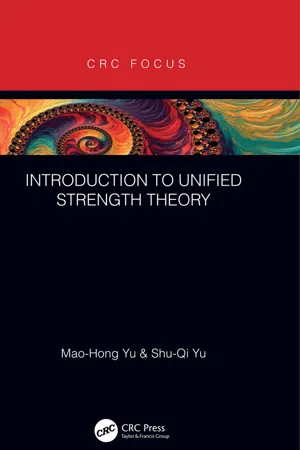1.1 Strength of materials in tension and compression
Strength theory deals with the yield or failure of materials under the complex stress state (combined stress state or multi-axial stress state). It is very important in solid mechanics and engineering. The uniaxial tensile and compressive strength of material can be obtained by simple test equipment. This kind of experimental equipment can be found at most engineering colleges and in many factories. The stress-strain curves of mild steel and iron in tension and compression are shown in Figures 1.1 and 1.2, respectively. The two figures show that there exist a tensile yield or failure point and a compressive yield or failure point at which the material will begin to deform plastically or failure. These two figures are well-known for students and engineers.
For most homogeneous, continuous and isotropic materials, the axial tensile strength (σt) is different from the axial compressive strength (σc). The yield stresses of some materials, such as mild steel, are identical both in tension and compression, as shown in Figure 1.1.
1.2 Strength of materials under complex stress
Most materials are acted upon under a complex stress state. If we take the tension as a positive and compression as a negative, the stress state may be presented as a stress point in a three-dimensional space. The stress point could be situated anywhere within the three-dimensional space of the principal stresses as shown in Figure 1.3. The stress point P (σ1, σ2, σ3) of different signs could combine up to eight quadrants of (+ + +), (+ + -), (+ - +), (+ - -), (- + +), (- + -), (- - +) and (- - -).
For example, there is a material with axial tensile strength on point A (σ1 = σt, σ2 = 0, σ3 = 0) and axial compressive strength on point B (σ1 = σc, σ2 = 0, σ3 = 0). It is seen that the axial tensile and compressive strengths are different. The strength of material under the general
Figure 1.1 Stress-strain curve of steel
Figure 1.2 Stress-strain curve of iron
stress state, such as point P in Figure 1.3, is far more complicated than that in a simple stress state. The strength of materials under the complex stress state (bi-axial stress or tri-axial stress) is hard to determine because the experimental equipment is rare and very expensive. Furthermore, the cases of the combination of complex stresses (σ1, σ2, σ3) are enormous.
Figure 1.3 Eight quadrants in principal stress space
Generally, the strength of materials under a complex stress state can be regarded as a function of stress state. This function is generally referred to as a strength theory. Sometimes the strength function is also referred to as yield criterion, failure criterion or strength hypothesis. It can be expressed by three principal stresses and several material parameters, as follows:
The parameter of strength of materials should be obtained by common and well-established experiments. Generally, the tensile strength σt and compressive strength σc are easy to obtain, hence Eq. 1.1 can be expressed as a function of three principal stresses and two material parameters:
If σt = σc, the two parameters can be simplified as one, i.e. σt = σc = σy, and the equation may be written as:
1.3 Single strength theory
A lot of yield criteria and failure criteria have been proposed. Most of them can only be adopted for one kind of material. These criteria can be referred as the single strength theories or single failure criteria. Some basic strength theories were proposed, including maximum principal stress theory (Rankine, 1861), maximum principal strain theory (de Saint-Venant, 1870), maximum shear stress theory (Tresca, 1864; Guest, 1900), maximum distortion energy theory (Huber, 1904; Mises, 1913), maximum deviatoric stress theory (Burzynski, 1928; Schmidt, 1932; Ishlinsky, 1940; Hill, 1950; Haythornthwaite, 1961) or twin-shear yield criterion (Yu, 1961, 1983), Mohr-Coulomb criterion (Coulomb, 1773; Mohr, 1900), twin-shear strength theory (Yu et al., 1985) and so on.
Maximum principal stress theory (Rankine criterion)
This assumes tha...



